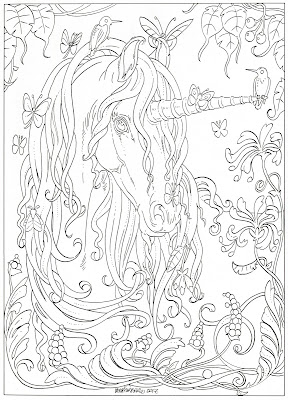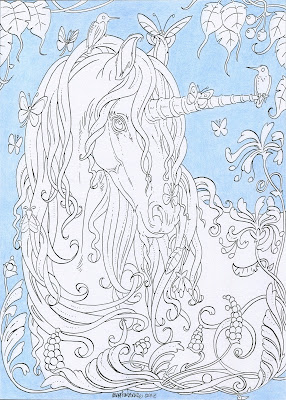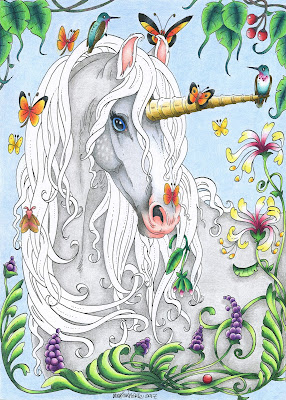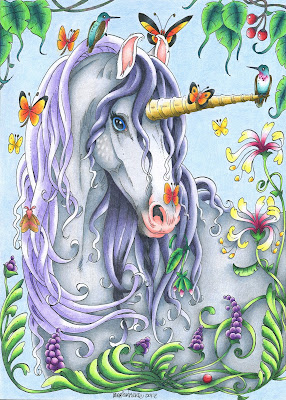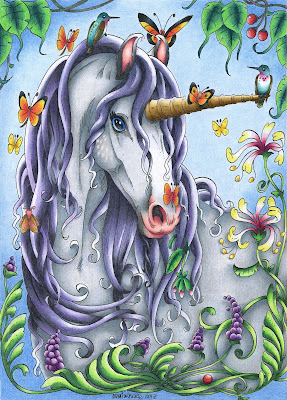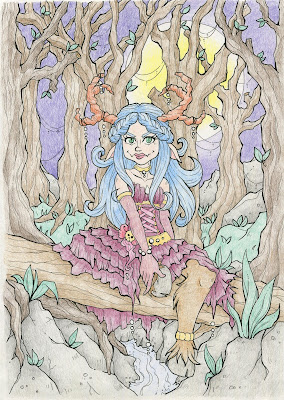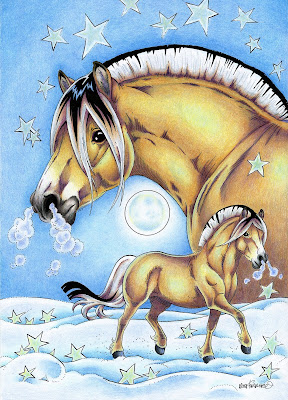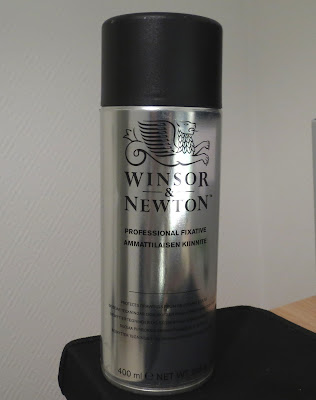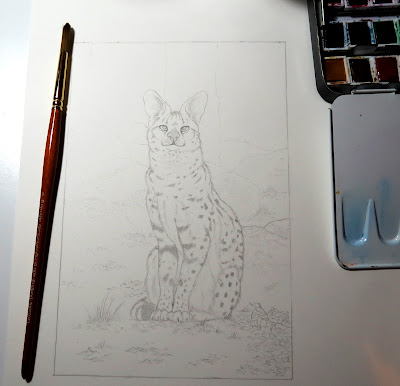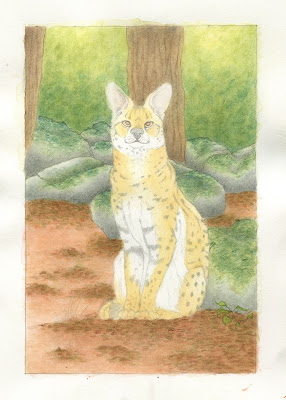Right now I want to talk about vegan art supplies. This is something that I discussed with at least a couple of people before but the blog post never happened. I'm sorry.
There are already a lot of blog posts out there that list vegan-friendly art supplies. However, most of those handle the big, known brands and are mostly centered around the selection available in the US.
Disclaimer!
I'm not vegan. I'm just someone who tries to be more conscious of what I buy and how I spend my materials. I support environmentally friendly companies and try to use my supplies to the best of their abilities and recycle what I can. But I'm not perfect. I still use disposable products that contain plastic for example. Art in itself is never sustainable. The main point of this blog post is to raise awareness about eco-friendly companies and supplies.Things to look out for
So do the supplies you're about to purchase contain animal derived ingredients? Some things to look out for are:- Bone black pigment (pigment made from bones, used in a lot of black pigments)
- Gelatin (animal glue, used to coat watercolor papers to make the surface more durable)
- Animal hairs in brushes
- Ox gall (used in watercolors to improve the flow of the paint, even sold in separate bottles)
There are a lot of other animal ingredients. Most companies have some kind of separate vegan list or they make the statement in the product description itself. It's also worth it to pay attention to certificates. FSC being one example. It tells you that the wood that's being used in the making of the product is harvested from sustainably managed forests. Faber Castell, for example, operates under this certificate.
A very good and extensive list of vegan art supplies can be found here: https://doublecheckvegan.com/vegan-art-supplies/
My vegan supplies
Rather than listing everything out there (there are already a lot of those lists) I'm going to go through my selection of supplies. These supplies aren't that rare or hard to get. At least inside EU. The prices aren't bad either. I don't want people to think that in order to buy environmentally-friendly and vegan art supplies, they have to pay an arm and a leg. I work mixed-media using watercolors and colored pencils.Graphite pencils:
I've used Staedtler Mars Lumograph pencils for a long time. They are very easily available and the lead is very durable and smooth. I'm not 100% sure if they are vegan but the company cares deeply about nature and sustainable production and the wood they use is FSC certified. Considering the fact that graphite is not an animal-based ingredient, it's safe to say that the pencils are vegan.
Another safe bet is Faber Castell. I have some of their pure graphite sticks and they are awesome. The 9000 graphite pencil range is easily available. Faber Castell also has mechanical pencils and clutch pencils.
Fineliners:
My favorite fineliners are Pigma Microns which are vegan. They are lighfast and waterproof and are very easily available. Pretty cheap too. They come in several different colors and sizes and there are also brush tipped pens available.
Another safe bet is, again, Faber Castell. They have fineliners, brush pens and big brush pens.
Colored pencils:
I use Faber Castell Polychromos. These are professional-level oil-based pencils that layer beautifully and the full set has 120 colors. For us Europians these pencils aren't expensive at all. You can find the sets in most places and if you're struggling to find a retailer with open stock pencils, you can always check out Jackson's Art Supplies. They have world-wide shipping. Faber Castell produces vegan friendly supplies and operate under FSC certificate.
I also use Caran D'Ache Luminance pencils to compliment my Polychromos. These are highly lightfast, wax-based pencils. The full range consists of 76 colors. The pencils are vegan-friendly and the company operates under FSC certificate. Luminance pencils are a great compliment to oil-based pencils as being wax-based they blend a lot better and the white pencil in particular is amazing for blending and bringing shades a bit lighter.
 |
| Faber Castell Polychromos. Set of 120. |
Derwent InkTense:
I like to use InkTense by Derwent for less serious projects like greeting cards and coloring book works. The lightfastness is a bit of an issue but as Lisa from Lachri Fine Art has stated several times, you can always make prints out of the finished illustrations. Both the pencil line and the block line has been stated to be vegan-friendly. Both ranges consist of 72 colors.
 |
| InkTense blocks. Set of 72. Cover illustration by Lisa Clough from Lachri Fine Art. |
Watercolors:
Back in the day I started out with RoyalTalens VanGogh watercolor paints. These are student-grade paints but don't let that fool you. The colors are highly lightfast and the paints perform very well. They are available in half-pans and tubes. I recently purchased a few tube colors since I've never tried tube watercolor before. The current range consists of 72 colors with the special Dusk, Metallic and Interference colors having been added to the selection.
After using my VanGoghs for a while I stepped up to their professional range of Rembrandts. These professional-level watercolors are very reasonably priced and all colors layer very beautifully. I bought the 48 color half-pan set and added a few colors to my selection. I now stand at a whopping amount of 52 colors. It wasn't exactly free to buy this many colors but the price was way WAY lower than it would've been for, say, Schminke watercolors which contain ox gall. Rembrandt color range is also highly lightfast so I didn't have to stick my nose to the color chart trying to dodge weaker or even fugitive colors. The full range consists of 120 colors (the color chart on their site is brand new, the series is undergoing renovation right now).
Both RoyalTalens watercolors are vegan-friendly (except for the color Lamp Black) and do not contain ox gall (verified by RoyalTalens representative).
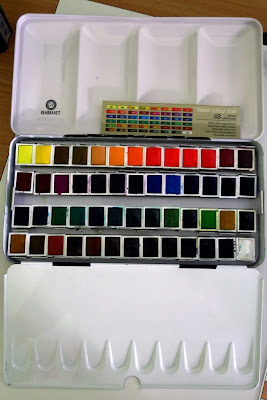 |
| My set of Rembrant watercolors. |
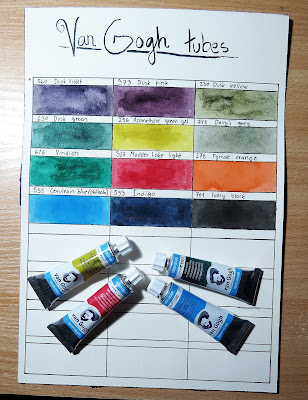 |
| Some VanGogh watercolor tubes that I recently bought. |
Brushes:
The vegan information for brushes is surprisingly hard to find. I didn't really find any dead-set information about the brushes that I use. However, the main point here is to use synthetic brushes. There's a huge selection of synthetic brushes available these days. Just make sure the brush really is synthetic and not, for example, a synthetic-natural hair mix. I personally use ProArte Prolene Plus brushes, Escoda Perla brushes and I also have an Escoda Ultimo mop brush. Jackson's Art Supplies states that their synthetic studio brushes are vegan.
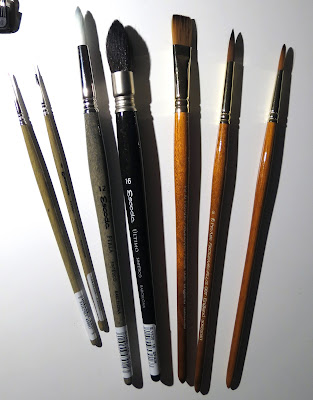 |
| Some of my brushes. Escoda Perlas, Escoda Ultimo Mop and ProArt Prolene Plus brushes. All fully synthetic. |
Misc. supplies:
I use a bunch of other supplies that I'd rather not list separately. In general, when buying miscellaneous art supplies like erasers, sharpeners, containers etc. just pay attention to the company making them and get as much use out of the supplies as possible. I use regular erasers very little and the ones I have are from Faber Castell or Caran D'Ache. I prefer to use a kneaded eraser. I use one eraser for years. Literally.
I use Staedtler can sharpeners most of the time. This is a bit of an annoyance since they are disposable and made of plastic. The sharpener itself doesn't last THAT long. I'm actually considering moving on to those small metal sharpeners and getting a big container to store my pencil shavings. At least by doing that, I would be able to toss the dulled out sharpeners to metal recycling bins. I have a Jakar crank operated table sharpener but I find that it just chews through my pencils way too aggressively.
I have plastic water cups. But I've used those for years and once I'm done with using them, they will go to plastic recycle bins now that we have those in Finland. For palettes, I use porcelain.
Now masking fluid is tricky. A few sites did claim that Pebeo Drawing Gum is vegan but I'm not 100% certain. The annoying thing about masking fluid is that it goes bad relatively fast. Honestly, you're better off learning how to paint around your subjects whenever possible.
Then there are other things like solvents, fixatives, white inks. I personally don't use solvents for my colored pencil work. I never got it to work for me and I started to use watercolor underpainting instead. I know there's stuff like Zest-It which is supposed to be non-toxic. The official version smells utterly horrible and gave me migraines. The citrus-free version is far more neutral. I just feel very eery about solvents as a whole and I want none of that stuff in my home, on my skin or close to my indoor cat or asthmatic fiancé.
Fixatives are another very difficult subject. There's SpectraFix which is a milk casein based natural fixative. The problem with this fixative is being able to spray it evenly. It can produce very large globules. It's also very wet so keep it away from lighter papers. People have had some success with those new spray cans that develop an even mist when pumped. I need to try that in the future. Then there's Brush & Pencil Final Fixative which is non-toxic. However, getting this product to Finland costs an arm and a leg in shipping. I have tried the Textured Fixative though and it also has a tendency to spray large, uneven globules. The thing about fixing your works is that you simply don't want to ruin hours and hours of work by using a bad fixative. I've used Winsor & Newton Professional Fixative for years. I do feel bad about using it but I just haven't been able to find an alternative. The best thing I can do is to ensure that I use a can to the very last drop, then recycle the can.
For white ink details I like to use Aerocolor ink by Schminke and FW Acrylic ink by Daler Rowney. Both are listed in some vegan lists. I also have Uni-Posca white paint markers and I've seen these in some vegan lists. I'm not 100% sure about either of these though so you'll have to re-check yourself.
 |
| Some miscellaneous stuff. |
 |
| SpectraFix natural fixative. |
Papers:
Now this is a big one. Paper manufacturing is never quite environmentally - friendly but by choosing and supporting companies that strive for sustainability you're already helping.
With watercolor papers in particular, you might come across the term 'sizing'. This means that the surface of the paper is sort of sealed so that it handles water better and does not get damaged so easily by masking fluid or scrubbing. The problem is that a lot of papers are sized with gelatin which is animal glue made through the process of boiling different animal ingredients like bones.
https://www.peta.org/about-peta/faq/what-is-gelatin-made-of/
!!! Some well-known and popular papers like Arches and Saunders Waterford contain gelatin. !!!
Here's a list of paper manufacturers whose papers I use. Specific papers that I have are listed in brackets. All these companies make vegan-friendly paper and support sustainable manufacturing:
- Hahnemühle (Nostalgie, Anniversary, Bamboo mixed-media, Grey Book, Britannia hot press)
- Fabriano (Fabriano 5 HP old surface, Fabriano Artistico is also very popular)
- Canson Moulin DuRoy hot press
- Stonehenge Aqua hot press (my go-to paper)
- Strathmore (Bristol Vellum & Smooth, Mixed Media in white, tan and grey)
 |
| Hahnemühle Bamboo mixed media, Hahnemühle Anniversary, Hahnemühle Nostalgie and Starthmore Bristol Smooth. |
For sketching I use several different papers like Daler Rowney smooth heavyweight cartridge paper or a Finnish drawing paper that is produced by a Finnish company who uses local forests and complies to environmentally friendly production. I've also started to work digitally at the drawing phase. Yes, this uses electricity but saves in paper waste since I can just re-work the drawing as much as I want. I use a black & white laser printer. By using a laser printer I don't have to buy ink cartridges all the time and I'm only using black color.
These are the supplies that I personally use. If you use any other medium like acrylics or oils you can easily find information and articles. Here's a great article made by Jackson's Art Supplies:
https://www.jacksonsart.com/blog/2017/03/08/art-supplies-animal-ingredients/
Ending note
As I said in the beginning, art is never environmentally friendly or sustainable in itself. But you can make smarter choices:
- Support environmentally friendly companies that state their principles and certificates clearly. If they give out information freely and openly, they have nothing to hide. If they are reluctant to give information, they're probably on the sketchy side or they just don't care.
- If you're uncertain about a product, ask the company! If they care and want to reply, they will. You might have to try different channels. For example Royal Talens replied to my inquiry on Facebook and Derwent replied very quickly on Instagram.
- Try to get the best out of your products. Use the stuff you buy to the last drop. I'm a horrible paper hoarder. I've made the decision to NOT buy any new papers or sketchbooks until I've used up most of the stuff I have in my closet. This might as well take me the rest of my life :D
- Recycle everything you can. Metal parts, plastic, paper (!).
- Try to buy locally from inside your own country. Not only will you support local companies but you will also lessen the burden of logistics. Thankfully, I can now buy most of my supplies from Finland.
- Try to find your favorite tools and stick with them. Jumping between mediums is expensive, taxing and it easily creates a situation where your closet is full of supplies never to be used again. I've been guilty of this more than once. Try to sell the ones you didn't like or maybe consider donating them to a school or community college. You can also keep them around so you can give them to someone as a gift. Don't just dump them in the trash!
- If using digital tools, try to be smart about it. You can transfer your reference photos to a smart phone or a tablet and use those instead of keeping your computer running. I have a relatively powerful gaming computer and I'd rather not keep it on all day if I don't absolutely need it. If you have a good amount of daylight, use that as your light when you draw and paint. No need to keep the lights on all the time.
- If you want to make prints out of your artwork, consider using an external company. They already have the hardware and the inks to produce the products that you want. No need to go out there and buy a new printer, new inks and all that paper.
- Try to search the internet for tutorials and videos rather than buying a new book every time. I have way too many books myself. The internet is incredibly vast and packed with information. Accessing that information is easier than ever. So use it.





